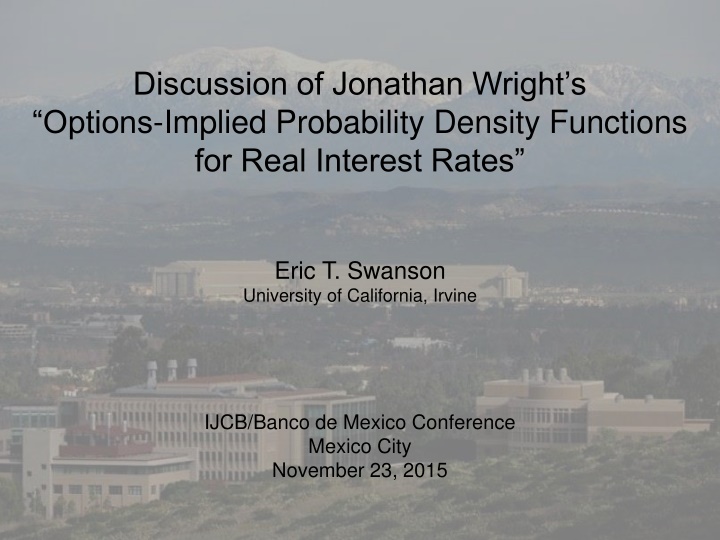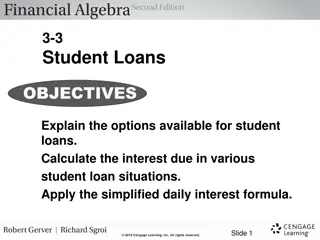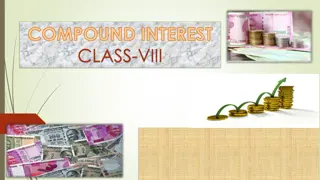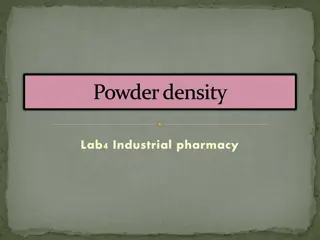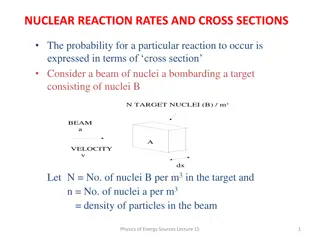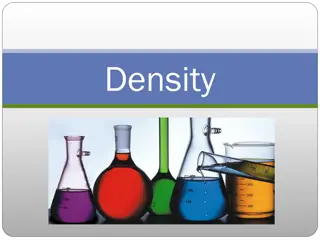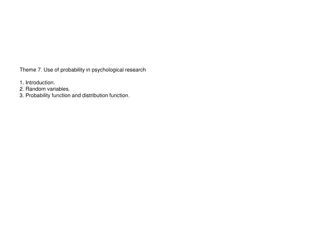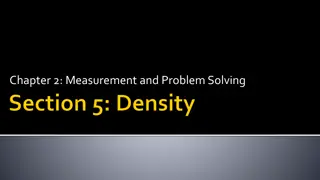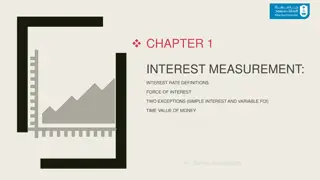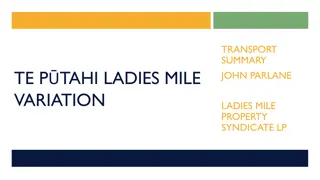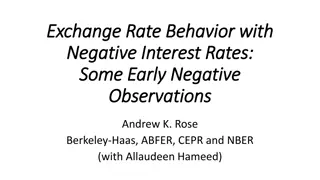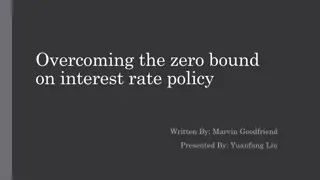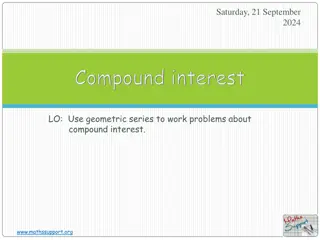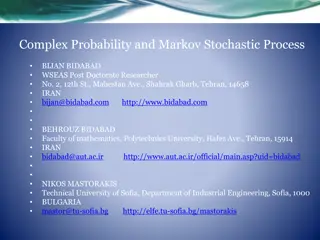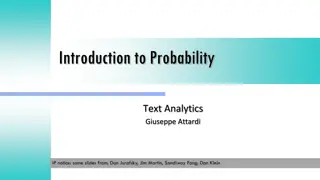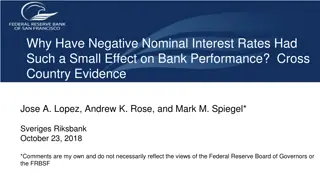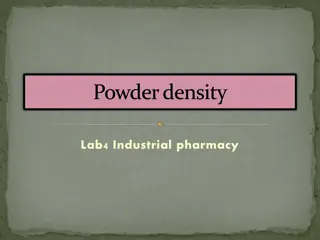Options-Implied Probability Density Functions for Real Interest Rates
Using new data on TIPS options, this paper computes implied probability distributions for real interest rates. Challenges with short sample options are discussed, along with the impact of the Financial Crisis on TIPS-Treasury mispricing. Evaluating implied PDFs and biased forecasts for TIPS yields are also examined.
Download Presentation

Please find below an Image/Link to download the presentation.
The content on the website is provided AS IS for your information and personal use only. It may not be sold, licensed, or shared on other websites without obtaining consent from the author.If you encounter any issues during the download, it is possible that the publisher has removed the file from their server.
You are allowed to download the files provided on this website for personal or commercial use, subject to the condition that they are used lawfully. All files are the property of their respective owners.
The content on the website is provided AS IS for your information and personal use only. It may not be sold, licensed, or shared on other websites without obtaining consent from the author.
E N D
Presentation Transcript
Discussion of Jonathan Wrights Options-Implied Probability Density Functions for Real Interest Rates Eric T. Swanson University of California, Irvine IJCB/Banco de Mexico Conference Mexico City November 23, 2015
What the Paper Does Use new data on TIPS options to compute implied probability distributions for real interest rates.
Difficulties Short sample Options on TIPS began trading in January 2009 Low volume Total trade volume is about 49 contracts/day Large bid/ask spreads (18%!) Even midpoints of bid/ask quotes have problems: Only available for about 10 strikes/day These 10 strikes are not well distributed (many are deep in the money), which makes them less informative Financial Crisis occupies a significant part of the sample Risk premia large and variable
Financial Crisis TIPS-Treasury mispricing (Fleckenstein-Longstaff-Lustig 2014)
Comment #1: Data Are Weird Quotes not available for nearly as many strikes as you d expect Quotes that do exist are oddly distributed: Many quotes are for deep in-the-money strikes Only 15% of quotes are for out-of-the-money strikes Only about 2% of quotes are for strikes that are >10% out of the money Seem to be very few puts early in sample Comment/Suggestion: Check with CBOE/data provider so we understand better what s going on
How to Evaluate Implied PDFs Literature on evaluating forecast densities (Diebold, Gunther, Tay, 1998; Berkowitz, 2001) Convert PDF to CDF, then map CDF to unit interval:
TIPS PDF Forecasts Were Biased Upward Options consistently over-predicted TIPS yields r = i So options either over-predicted i, or under-predicted (Recall: predictions are for 7-year TIPS 3 or 6 months ahead)
Nominal U.S. Treasury Yields, 2009-2014 source: Swanson and Williams (2014)
Blue Chip Forecasts of Time to First Tightening source: Swanson and Williams (2014)
Comment #2: Discuss Bias in Implied PDFs Test for bias Discuss reasons for bias/nonuniformity: Risk premium? Or forecast errors? Currently, paper takes a strong position that it s risk premium But there s substantial evidence of nominal interest rate forecast errors during this period
Estimating Options-Implied PDFs Two main approaches: 1. Assume a parametric form for PDF and estimate parameters to fit observed options prices 2. If options pricing function p(K) is known, can compute PDF for the underlying as d2p/dK2 (In practice, p(K) is not known but must be estimated)
Parametric Form for PDF Step function is one common parametric form: Implied PDF for Eurodollar rate 5 quarters ahead, 11/2/2011 Another common form is mixture of 2 or 3 normals (fewer parameters than step function)
Estimating Option-Pricing Function p(K) Assume options pricing function has form p(S,K, ,d, ,r) S = spot price of underlying K = option strike price = volatility (and higher moments of stochastic distribution) d = dividends from underlying = time to expiration r = risk-free interest rate (nominal) from now to expiration Can estimate function p parametrically or nonparametrically
Estimating p Parametrically Transform options prices to Black-Scholes implied vols Fit quadratic or spline to implied vols to get smooth function Transform implied vol function back to pricing function p(K)
Sparse Data Can Be a Problem But 10 observations/day is not bad
Estimating p Nonparametrically Sparse data not normally a scenario for nonparametric estimation Idea: combine data from similar days Instead of estimating p(K) on a single day, estimate p(S,K, ,d, ,r) nonparametrically over whole sample Let be a function of state of economy Case 1: (S,K, ) Case 2: (S/K, , EGARCH) Case 1 problematic: averaging uncertainty over whole sample (uncertainty about real rates in 2009 same as in 2013)
Comment #3: Justify Nonparametric Estimation Case 1 is too crude better to drop it Case 2 is reasonable, but requires the EGARCH model to be good to produce good results. It s also very complicated. Parametric estimation is simpler, removes dependence on auxiliary model 10 observations/day should be plenty to get a good implied volatility fit (Bliss-Panigirtzoglou (2002) had 10.8 strikes/day for short sterling futures, found parametric implied vol smile method worked very well) Need to justify nonparametric approach for these data
Comment #4: Standard Errors Seem Too Small Given data sparseness and giant bid-ask spreads, these standard error bands seem far too narrow
Summary of Comments and Suggestions 1. Data are weird in a number of respects check with CBOE/data provider for insights 2. Implied PDFs were upward biased risk premium, or forecast errors? 3. Justify nonparametric estimation method parametric implied volatility smile an appealing alternative 4. Standard error bands around PDFs seem too narrow
